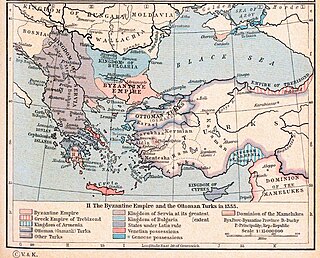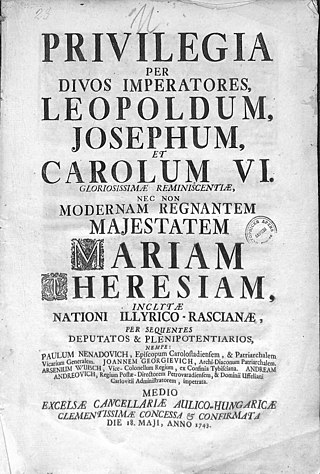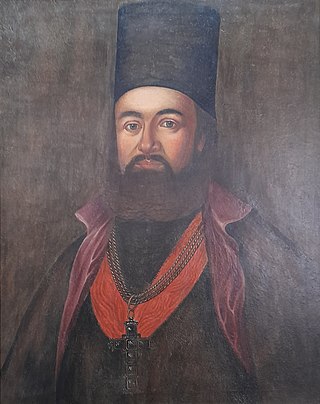
Serbian diaspora refers to Serbian emigrant communities in the diaspora. The existence of a numerous diaspora of Serbian nationals is mainly a consequence of either economic or political reasons.
Šajkaši refers to the river flotilla troops guarding the Danube and Sava, and especially, the Port of Belgrade, against the Ottoman Empire from the 16th to the 19th century. During that period, the rivers were natural borders of the Kingdom of Hungary and Habsburg monarchy with the Ottoman Empire, part of the Military Frontier. The troops were composed of ethnic Serbs, who had special military status. Their name derives from the small wooden boat known as chaika, a type of galley.

Josif Rajačić, also known as Josif Rajačić-Brinski, was a metropolitan of Sremski Karlovci, Serbian Patriarch, administrator of Vojvodina, and baron.

The Serbian Vojvodina was a short-lived self-proclaimed Serb autonomous province within the Austrian Empire during the Revolutions of 1848, which existed until 1849 when it was transformed into the new (official) Austrian province named Voivodeship of Serbia and Banat of Temeschwar.

The Voivodeship of Serbia and Banat of Temeschwar or Serbian Voivodeship and the Banate of Temes, known simply as the Serbian Voivodeship, was a crownland of the Austrian Empire that existed between 1849 and 1861.

Rascians was a historical term for Serbs. The term was derived from the Latinized name for the central Serbian region of Raška. In medieval and early modern Western sources, exonym Rascia was often used as a designation for Serbian lands in general, and consequently the term Rasciani became one of the most common designations for Serbs. Because of the increasing migratory concentration of Serbs in the southern Pannonian Plain, since the late 15th century, those regions also became referred to as Rascia, since they were largely inhabited by Rasciani (Rascians). Among those regions, term Rascia (Raška) was most frequently used for territories spanning from western Banat to central Slavonia, including the regions of Syrmia, Bačka, and southern Baranja. From the 16th to the 18th century, those regions were contested between the Ottoman Empire and the Habsburg monarchy, and today they belong to several modern countries.

The History of the Serbs spans from the Early Middle Ages to present. Serbs, a South Slavic people, traditionally live mainly in Serbia, Montenegro, Bosnia and Herzegovina, Croatia and North Macedonia. A Serbian diaspora dispersed people of Serb descent to Western Europe, North America and Australia.

The Great Migrations of the Serbs, also known as the Great Exoduses of the Serbs, were two migrations of Serbs from various territories under the rule of the Ottoman Empire to the Kingdom of Hungary under the Habsburg monarchy.
The Serbs in Hungary are recognized as an ethnic minority, numbering 7,210 people or 0.1% of the total population. The number of Serbs in Hungary has drastically diminished; in the 16th, 17th and 18th centuries large Serb communities existed throughout Hungary, notably in Buda, Baja, Szentendre and Szeged. The Serb community in the territory of present-day Hungary has its origin in migrations from the territory of medieval Serbian states during and after the Ottoman conquest of these states. Matthias Corvinus and his successors are known to have welcomed Serbs from the other side of the Danube, giving the exiled military commanders fiefdoms to rule and defend from the Ottomans. After the dissolution of Austro-Hungarian monarchy in 1918 and after new borders were defined by the Treaty of Trianon in 1920, only a small fraction of ethnic Serbs remained within the borders of post-Trianon Hungary.

Arsenije III Crnojević was the Archbishop of Peć and Serbian Patriarch from 1674 to his death in 1706. In 1689, during the Habsburg-Ottoman War (1683–1699), he sided with Habsburgs, upon their temporary occupation of Serbia. In 1690, he left the Patriarchal Monastery of Peć and led the Great Migration of Serbs from Ottoman Serbia into the Habsburg monarchy. There he received charters, granted to him by Emperor Leopold I, securing religious and ecclesiastical autonomy of Eastern Orthodoxy in the Habsburg Monarchy. In the meanwhile, after restoring their rule in Serbian lands, Ottomans allowed the appointment of a new Serbian Patriarch, Kalinik I (1691–1710), thus creating a jurisdictional division within the Serbian Orthodox Church. Until death, in 1706, Patriarch Arsenije remained the head of Serbian Orthodox Church in Habsburg lands, laying foundations for the creation of an autonomous ecclesiastical province, later known as the Metropolitanate of Karlovci.
Kalinik I was the Archbishop of Peć and Serbian Patriarch, head of the Serbian Orthodox Church from 1691 until 1710.

Serbs are, by large, first or second generation immigrants from other republics of former Yugoslavia. In the 2002 census, 38,964 people of Slovenia declared Serb ethnicity, corresponding to 2% of the total population, making them the largest ethnic minority in the country.

May Assembly was the national assembly of the Serbs in Austrian Empire, held on 1 and 3 (O.S.) [13 and 15 (N.S.)] May 1848 in Sremski Karlovci, during which the Serbs proclaimed autonomous Serbian Vojvodina. This action was later recognized by the supreme Austrian authority in Vienna. The May Assembly was part of the European Revolutions of 1848.

The Freedom Party of Austria is a national-conservative and right-wing populist political party in Austria. It has been led by Herbert Kickl since 2021. It is the third largest of five parties in the National Council, with 30 of the 183 seats, and won 16.2% of votes cast in the 2019 legislative election and it is represented in all nine state legislatures. On a European level, the FPÖ is a founding member of the Identity and Democracy Party and its three MEPs sit with the Identity and Democracy (ID) group.

Eastern Orthodoxy in Austria refers to communities, institutions and organizations of the Eastern Orthodox Christianity on the territory of modern Austria. There are several Eastern Orthodox jurisdictions in Austria. As of 2019, it is estimated that there are some 400,000 to 450,000 Eastern Orthodox believers in Austria. Most of them are ethnic Serbs and Romanians.

Serb diaspora refers to the diaspora communities of ethnic Serbs. It is not to be confused with the Serbian diaspora, which refers to migrants, regardless of ethnicity, from Serbia. Due to generalization in censuses outside former Yugoslavia to exclude ethnicity, the total number of the Serb diaspora population cannot be known by certainty. It is estimated that 2–3 million Serbs live outside former Yugoslavia.

Goran Djuricin is an Austrian football manager, coach and former player.

The Serbian Orthodox Eparchy of Austria and Switzerland or Serbian Orthodox Diocese of Austria and Switzerland is an eparchy (diocese) of the Serbian Orthodox Church, created in 2011, with jurisdiction over Serbian Orthodox churches in Austria, Switzerland, Italy and Malta. Its headquarters are located in Vienna, Austria.

Isaija Đaković or Isaija I was elected to the rank of Metropolitan of Krušedol (Karlovci) in 1708. Isaija is best remembered as the first Serbian metropolite under Habsburg monarchy and for his diplomatic skills when he obtained the amendments in the Privileges. He was succeeded by Sofronije Podgoričanin.
Sofronije Podgoričanin was a Serbian Orthodox bishop who served in the Eparchy of Slavonia from 1705 to 1710 and was elevated to the Metropolitan of Krušedol from 1710 to 1711.




























